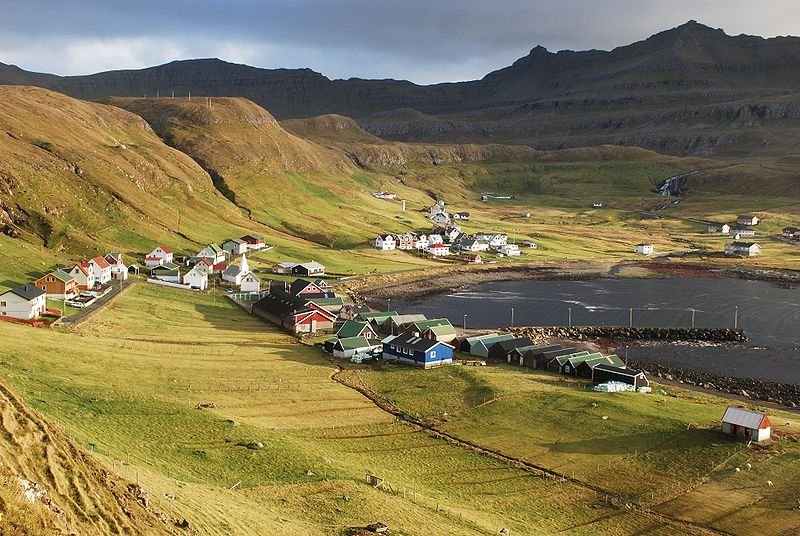 Village of Fámjin on Suðuroy, Faroe Island
Village of Fámjin on Suðuroy, Faroe IslandSource: https://commons.wikimedia.org/wiki/File:F%C3%A1mjin.10.jpg
Author: Erik Christensen

Faroe Islands is a small group of islands in the North Atlantic Ocean. It is located about equidistant from Iceland, Scotland and Norway. There are 18 main islands in the group located some 655 km (407 mi) from the coast of northern Europe. The islands are rocky with jagged coastline. The highest peak in the Faroe Islands is Slættaratindur, at 882 m (2,894 ft).
The Faroe Islands are today a constituent country within the Kingdom of Denmark, which includes Denmark proper and Greenland. It covers 1,399 sq km (540 sq mi) and has a population of 50,000 (2011 estimate) of which about 92% comprises local Faroese.
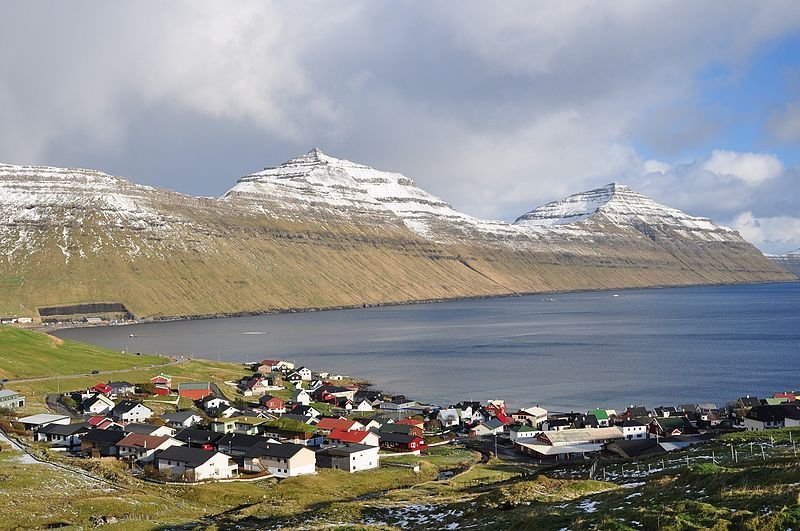 Gøtuvík Bay, Syðrugøta, on Eysturoy, Faroe Islands
Gøtuvík Bay, Syðrugøta, on Eysturoy, Faroe IslandsSource: https://commons.wikimedia.org/wiki/File:Faroe_Islands,_Eysturoy,_Sy%C4%91rug%C3%B8ta_%281%29_.jpg
Author: Vincent van Zeijst

The Faroe Islands is written as Føroyar in the local Faroese language and Færøeme in Danish. The Faroese language is one of the three branches of Scandinavian languages descended from the Old Norse language of the Vikings. The language faced suppression between the 15th and 19th centuries, when the ruling Danes prohibited it from being used in schools, churches and official documents, forcing the local population to maintain their language orally. Only with the relaxation of the language rule in the 19th century were the Faroese culture documented.
Faroe Islands is an hour ahead of Coordinated Universal Time (UTC+1). The phone IDD code is +298. The electricity is 230V/50Hz using European plug.
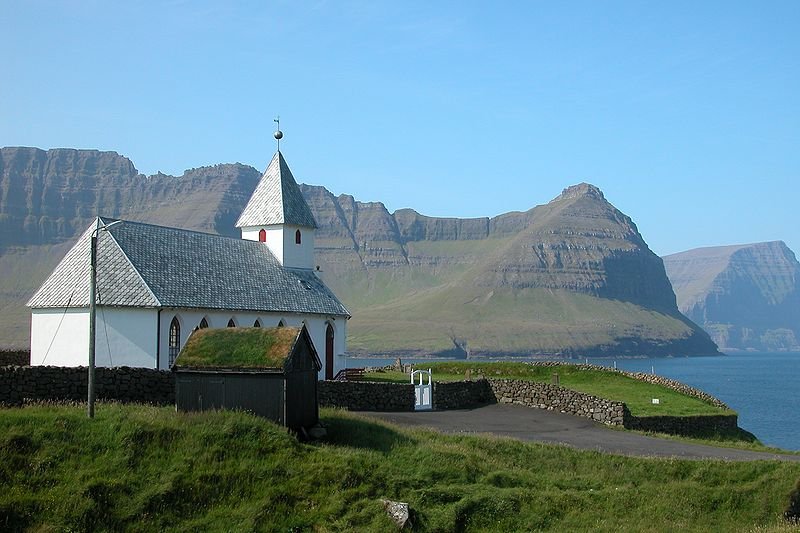 Church of Viðareiði on Viðoy, Faroe Island
Church of Viðareiði on Viðoy, Faroe IslandSource: https://commons.wikimedia.org/wiki/File:Church_of_Vi%C3%B0arei%C3%B0i,_Faroe_Islands.JPG
Author: Erik Christensen

Faroe Islands are today a parliamentary democracy and constitutional monarchy with Queen Margrethe II as the monarch. The capital and largest city is Tórshavn. The economy of the country was traditionally dependent on fishing, but since the collapse of the local fishing industry - at great loss of jobs - the islands have depended on economic aid from Denmark which accounts for approximately have its expense budget.
Faroe Island is heavily dependent on financial support from Denmark, which provide 20% of the islands' national budget. In 2008, the Faroe Islands had a nominal GDP of $2.45 billion, equivalent to $50,300 per capita. However, at purchasing power parity, the per capita GDP stood at $33,700.
Faroe Islands have an unemployment figure of just 1.1%, the lowest rate in Europe, although the figure has been criticized as misleading. The currency in use here is the Faroese króna (DKK). The country is moving towards holding a referendum on whether to adopt the Euro as the official currency.
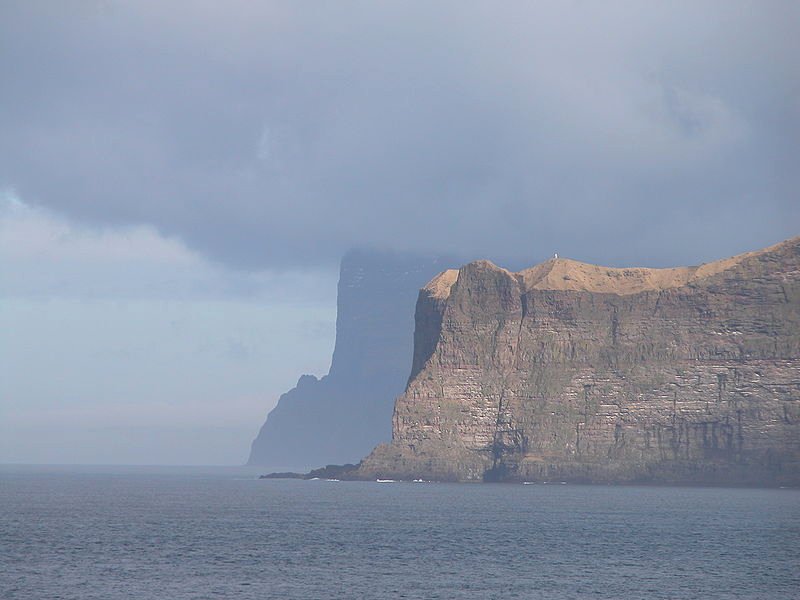 Cape Enniberg, Faroe Island
Cape Enniberg, Faroe IslandSource: https://commons.wikimedia.org/wiki/File:Enniberg.1.jpg
Author: Erik Christensen

Faroe Islands experiences a maritime subarctic climate. The Atlantic Ocean has a tremendous influence to its climate, particularly due to the North Atlantic Current. As a result, the winters here are mild, with average temperatures of 3-4°C (37-39°F) while the summers are warm, with temperatures averaging 10°C (50°F). Due to their location in the path of depressions, the Faroe Islands receive strong winds and heavy rains for much of the year.
Human settlement in the Faroe Islands may have started in the early part of the first millennium, but not much is known of it today. Early Norsemen visited and settled there as early as the 5th century AD. The Norsemen who settled there are believed to have come from the Irish Sea and Western Isles of Scotland, not directly from Scandinavia. They brought an Old Norse language which becomes the modern Faroese language spoken today.
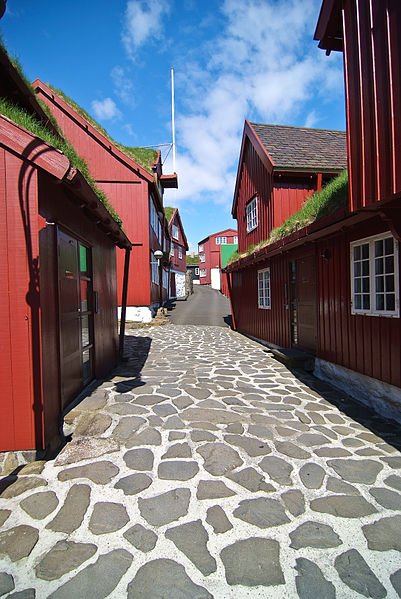 Tinganes, in Tórshavn, Faroe Island
Tinganes, in Tórshavn, Faroe IslandSource: https://commons.wikimedia.org/wiki/File:Tinganes,_Torshavn_01.jpg
Author: Arne List

Settlers from Norway landed in the Faroe Islands since the end of the 9th century. This resulted in Norway taking control of the islands until 1380, when Norway became part of the Kalmar Union with Denmark. When the union was dissolved in 1814, the Faroe Islands passed into the control of Denmark.
The Faroe Islands were occupied by British forces during World War II. After the war was over, it was returned to Denmark. In 1948, home-rule was introduced. In 1973, the Faroe Islands declined to join Denmark in entering the European Community, which is today the European Union.
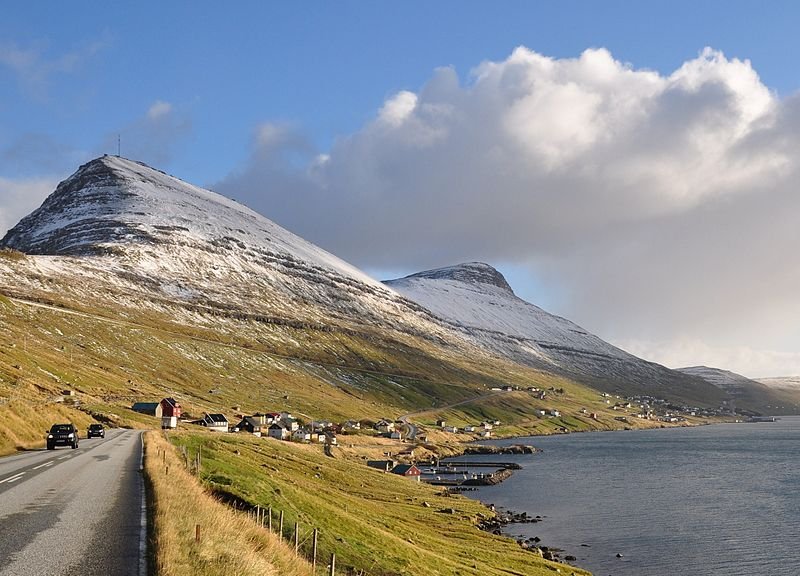 Faroe Island landscape
Faroe Island landscapeSource: https://commons.wikimedia.org/wiki/File:Faroe_Islands,_Eysturoy,_along_Sk%C3%A1lafj%C3%B8r%C3%B0ur,_approaching_Undir_G%C3%B8tuei%C3%B0i,
_Skipanes_and_S%C3%B8ldarfj%C3%B8r%C3%B0ur.jpg
Author: Vincent van Zeijst

Planning your visit to Faroe Islands
The Faroe Islands are not part of the Schengen Area. However there are no border checks for visitors entering it from the Schengen Area.The main airport for Faroe Islands is the Vágar Airport (Vága Floghavn, FAE), located on the island of Vágar, to the east of Sørvágar. It is the home base for national carrier Atlantic Airways, which offers flights to Copenhagen, Oslo and Reykjavík.
Exploring the Faroe Islands
There is a public transport system covering most of the towns on Faroe Islands. However, renting a car will make travel much more convenient. The different islands are connected by bridges and undersea tunnels.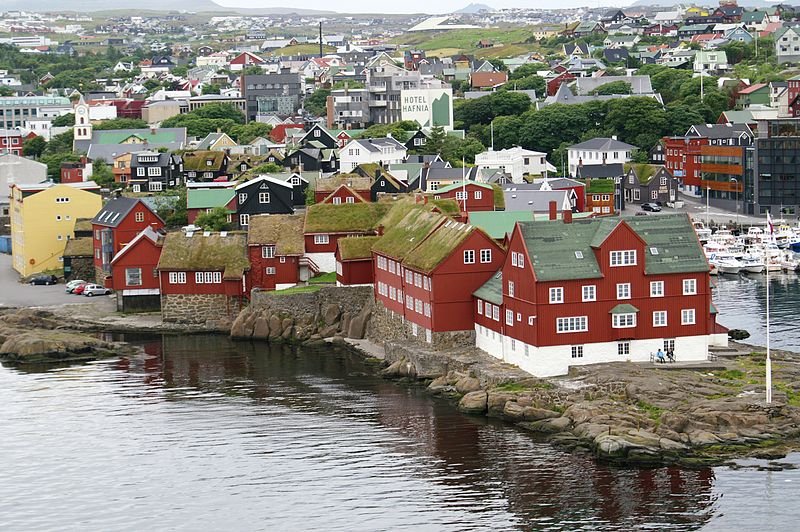 Torshavn, Faroe Islands
Torshavn, Faroe IslandsSource: https://commons.wikimedia.org/wiki/File:Zicht_op_Torshavn.jpg
Author: Dickelbers

Major Towns in Faroe Islands
- Tórshavn - capital
- Fuglafjørður
- Hoyvík
- Klaksvik
- Runavík
- Tvøroyri
- Vágur
Regions in Faroe Islands
- Northern Islands
- Eysturoy
- Northern Streymoy
- Southern Streymoy
- Vágar
- Sandoy
- Suðuroy
Places of Interest in Faroe Islands
- Beinisvord
- Rinkusteinar
- Risin og Kellingin
- Slættaratindur
- Toftavatn Lake
 Latest updates on Penang Travel Tips
Latest updates on Penang Travel Tips

Copyright © 2003-2025 Timothy Tye. All Rights Reserved.

 Go Back
Go Back